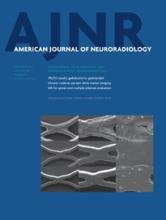Research ArticleBrain
Open Access
Percentage Insula Ribbon Infarction of >50% Identifies Patients Likely to Have Poor Clinical Outcome Despite Small DWI Infarct Volume
V.M. Timpone, M.H. Lev, S. Kamalian, L.T. Morais, A.M. Franceschi, L. Souza and P.W. Schaefer
American Journal of Neuroradiology January 2015, 36 (1) 40-45; DOI: https://doi.org/10.3174/ajnr.A4091
V.M. Timpone
aFrom the Department of Radiology, Massachusetts General Hospital and Harvard Medical School, Boston, Massachusetts.
M.H. Lev
aFrom the Department of Radiology, Massachusetts General Hospital and Harvard Medical School, Boston, Massachusetts.
S. Kamalian
aFrom the Department of Radiology, Massachusetts General Hospital and Harvard Medical School, Boston, Massachusetts.
L.T. Morais
aFrom the Department of Radiology, Massachusetts General Hospital and Harvard Medical School, Boston, Massachusetts.
A.M. Franceschi
aFrom the Department of Radiology, Massachusetts General Hospital and Harvard Medical School, Boston, Massachusetts.
L. Souza
aFrom the Department of Radiology, Massachusetts General Hospital and Harvard Medical School, Boston, Massachusetts.
P.W. Schaefer
aFrom the Department of Radiology, Massachusetts General Hospital and Harvard Medical School, Boston, Massachusetts.

References
- 1.↵
- Souza LC,
- Yoo AJ,
- Chaudhry ZA, et al
- 2.↵
- Yoo AJ,
- Barak ER,
- Copen WA, et al
- 3.↵
- Yoo AJ,
- Verduzco LA,
- Schaefer PW, et al
- 4.↵
- 5.↵
- Ay H,
- Arsava EM,
- Koroshetz WJ, et al
- 6.↵
- Fink JN,
- Selim MH,
- Kumar S, et al
- 7.↵
- Kamalian S,
- Kemmling A,
- Borgie RC, et al
- 8.↵
- Augustine JR
- 9.↵
- Torres-Mozqueda F,
- He J,
- Yeh IB, et al
- 10.↵
- Christensen H,
- Boysen G,
- Christensen AF, et al
- 11.↵
- Laowattana S,
- Zeger SL,
- Lima JA, et al
- 12.↵
- Truwit CL,
- Barkovich AJ,
- Gean-Marton A, et al
- 13.↵
- Moulin T,
- Cattin F,
- Crepin-Leblond T, et al
- 14.↵
- Payabvash S,
- Souza LC,
- Wang Y, et al
- 15.↵
- Türe U,
- Yasargil MG,
- Al-Mefty O, et al
- 16.↵
- Sander D,
- Winbeck K,
- Klingelhofer J, et al
- 17.↵
- Bruno A,
- Biller J,
- Adams HP Jr., et al
- 18.↵
- 19.↵
- Naidich TP,
- Kang E,
- Fatterpekar GM, et al
In this issue
American Journal of Neuroradiology
Vol. 36, Issue 1
1 Jan 2015
Advertisement
V.M. Timpone, M.H. Lev, S. Kamalian, L.T. Morais, A.M. Franceschi, L. Souza, P.W. Schaefer
Percentage Insula Ribbon Infarction of >50% Identifies Patients Likely to Have Poor Clinical Outcome Despite Small DWI Infarct Volume
American Journal of Neuroradiology Jan 2015, 36 (1) 40-45; DOI: 10.3174/ajnr.A4091
0 Responses
Percentage Insula Ribbon Infarction of >50% Identifies Patients Likely to Have Poor Clinical Outcome Despite Small DWI Infarct Volume
V.M. Timpone, M.H. Lev, S. Kamalian, L.T. Morais, A.M. Franceschi, L. Souza, P.W. Schaefer
American Journal of Neuroradiology Jan 2015, 36 (1) 40-45; DOI: 10.3174/ajnr.A4091
Jump to section
Related Articles
- No related articles found.
Cited By...
- Factors associated with unfavorable outcome after anterior circulation stroke despite successful reperfusion and early neurological improvement
- Relevance of Brain Regions' Eloquence Assessment in Patients With a Large Ischemic Core Treated With Mechanical Thrombectomy
- Insula stroke: the weird and the worrisome
- Association of Computed Tomography Ischemic Lesion Location With Functional Outcome in Acute Large Vessel Occlusion Ischemic Stroke
- Acute Ischemic Stroke Infarct Topology: Association with Lesion Volume and Severity of Symptoms at Admission and Discharge
- Effect of Right Insular Involvement on Death and Functional Outcome After Acute Ischemic Stroke in the IST-3 Trial (Third International Stroke Trial)
This article has not yet been cited by articles in journals that are participating in Crossref Cited-by Linking.
More in this TOC Section
Similar Articles
Advertisement











